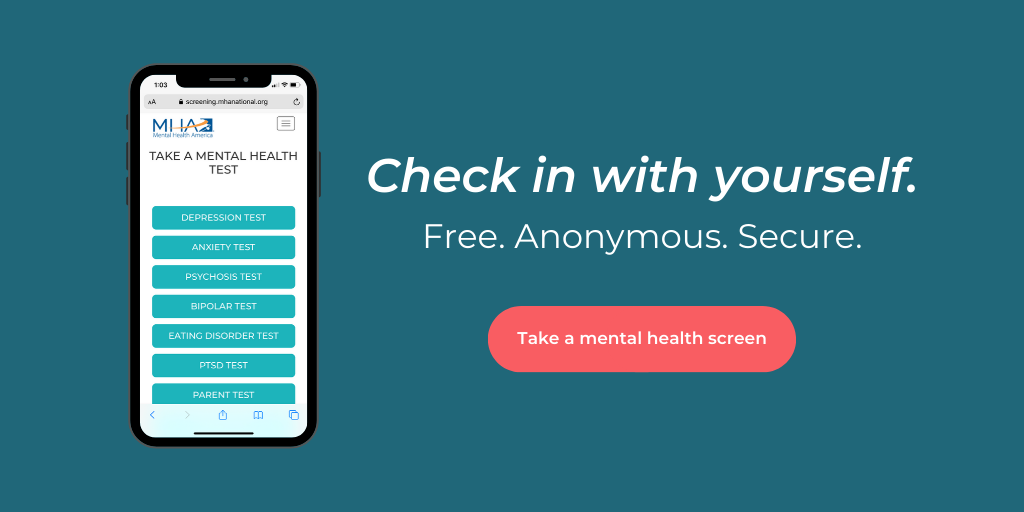A quick, easy and confidential way to determine if you may be experiencing PTSD is to take a screening. A screening is not a diagnosis, but a way of understanding if your symptoms are having enough of an impact that you should seek help from a doctor or other professional. Visit www.mhascreening.org to take a PTSD screen.
If you have gone through a traumatic experience, it is normal to feel lots of emotions, such as distress, fear, helplessness, guilt, shame or anger. You may start to feel better after days or weeks, but sometimes, these feelings don’t go away. If the symptoms last for more than a month, you may have post-traumatic stress disorder or PTSD.
"Posttraumatic Stress Disorder (PTSD) is an anxiety disorder that can occur following the experience or witnessing of a traumatic event. A traumatic event is a life-threatening event such as military combat, natural disasters, terrorist incidents, serious accidents, or physical or sexual assault in adult or childhood."[1]
PTSD is a real problem and can happen at any age. If you have PTSD, you are not alone. It affects over 12 million American adults (3.7% of the adult population) in any given year. [2]
- Anyone who was a victim, witnessed or has been exposed to a life-threatening situation.
- Survivors of violent acts, such as domestic violence, rape, sexual, physical and/or verbal abuse or physical attacks.
- Survivors of unexpected dangerous events, such as a car accident, natural disaster, or terrorist attack.
- Combat veterans or civilians exposed to war.
- People who have learned of or experienced an unexpected and sudden death of a friend or relative.
- Emergency responders who help victims during traumatic events.
- Children who are neglected and/or abused (physically, sexually or verbally).
For many people, symptoms begin almost right away after the trauma happens. For others, the symptoms may not begin or may not become a problem until years later. To meet criteria for PTSD, you have to have been exposed to some trauma that results in the following symptoms.
1. Reexperiencing the trauma in ways that make you feel distressed.
- Repeatedly thinking about the trauma. You may find that thoughts about the trauma come to mind even when you don’t want them to.
- Nightmares about the memories
- Flashbacks about the trauma
2. Avoidance
- Avoiding reminders of the trauma. You may not want to talk about the event or be around people or places that remind you of the event.
3. Changes in thoughts and mood
- Memory problem
- Negative thought about the world and yourself
- Feeling blame about the trauma
- Depression, isolation, sadness
- Isolation
- Difficulty relating or interacting with others
4. Feeling reactive
- Irritable, angry,
- Constantly alert or on guard
- Jumpy or easily startled
- Difficulty sleeping.
- Difficulty concentrating
PTSD is a problem when it gets in the way of living the life you want to live. It can effect work, school, and relationships.
Problems in daily living: having problems functioning in your job, at school, or in social
These are other symptoms of PTSD:
- Physical symptoms: chronic pain, headaches, stomach pain, diarrhea, tightness or burning in the chest, muscle cramps or low back pain.
- Substance abuse: using drugs or alcohol to cope with the emotional pain.
- Relationship problems: having problems with intimacy, or feeling detached from your family and friends.
- Depression: persistent sad, anxious or empty mood; loss of interest in once-enjoyed activities; feelings of guilt and shame; or hopelessness about the future. Other symptoms of depression may also develop.
- Suicidal thoughts: thoughts about taking one’s own life. If you or someone you know is struggling or in crisis, help is available. Call or text 988 or chat 988lifeline.org. You can also reach Crisis Text Line by texting MHA to 741741.
The current PTSD diagnosis applies to one event lasting for a short time however there is a growing group of professionals calling for a separate diagnosis to describe the long term emotional scarring following long-lasting trauma. While it is not an official diagnosis in the DSM-V, Complex PTSD/C-PTSD affects individuals who have experienced chronic inescapable traumas in which that they have had has little or no control over continuing for months or years at a time. It is important to note that you may have both PTSD and C-PTSD at the same time.
Who can get C-PTSD?
- People who have survived living in concentration camps.
- People who have survived prisoner of war camps.
- Survivors of long-term childhood physical and/or sexual abuse.
- Anyone who has been part of a prositution brothel.
- Survivors of long-term domestic violence.
PTSD and C-PTSD share many of the same symptoms, but literature has pointed to three symptoms exclusive to C-PTSD [3]
- Problems with emotional regulation.You might have a lessned sense of emotional sensitivity. You may lack the ability to respond to situations appropriately or feel you are unable to control your emotions.
- Problems with interpersonal relationships. You may have difficulty feeling close to another person; feel disconnected or distant from other people. It may be hard for you to maintain close relationships with family, significant others, or friends.
- Negative self-concept. You may have a poor perception of oneself. You might feel worthless, helpless, shame, guilt, and other problems related to self-esteem.
C-PTSD can be treated with the same evidence-based treatments that are effective for treating PTSD. However, some research suggests that therapy with a focus on reestablishing a sense of control and power for the traumatized person can be especially beneficial.[4]
Anxiety is about worry and fear. Worry and fear happens when something causes you to learn to be scared and worried. This learning process affects your thoughts and your body, for example by causing your heart to race or excessive sweating. You can treat anxiety by addressing the thoughts and physical reactions that are happening in your mind and body. For example, you can re-learn how to be around the thing that scares you and NOT react with fear, essentially retraining your thoughts and physical reactions.
Some examples of how to treat anxiety include:
Therapy: There are many different types of therapy. It can be a great way to change behaviors, gain confidence, learn new skills, and talk with someone openly and honestly. One of the most common and researched types of therapy for anxiety is Systematic Desensitization and Exposure Therapy. The main aspects of these types of treatment are slow exposure in uncomfortable situations, often in a safe environment with someone working with you to address the desire to run away. The goal is to do the thing you’re scared of and work on changing thoughts and behaviors.
Support groups: Support groups are made up of individuals with similar experiences, like anxiety, who meet regularly to discuss their experiences. There are many groups specific to anxiety, in addition to groups around broader issues. Talking to people who are going through the same things can make you feel less alone and more connected. It also creates a space where people can share what has worked for them and talk through their struggles with people who understand.
Medication: Another option is to take medications. Medications literally mellow you out and prevent your body from reacting in a fearful way. Anti-anxiety medications like Xanax or Klonopin are designed to work quickly to help calm you down by slowing down brain activity or communication between your body and brain. Unfortunately, these drugs can be very addictive. Another drug that can be used to treat anxiety is antidepressants.
Lifestyle Changes: Research shows exercise, meditation, and yoga can all improve mood and overall well being. Research also shows the importance of nutrition and certain supplements in supporting brain and mood. Other things like taking time to take care of yourself, trying activities you enjoy, and spending time with people or environments where you feel supported can help as well.
While there is no one simple answer, people do recover with a combination of supports. It can take some time to find out what works best for you, but it does get better.
Sexual Assault and Mental Health
Sexual assault can have a variety of short- and long-term effects on a victim's mental health.
Eating Disorders
Eating disorders are real, complex medical and psychiatric illnesses that can have serious consequences for health, productivity and relationships.
Coping with Disaster
If your community has been hit by a natural disaster, you’re probably trying to make sense of what happened and deal with the stress of the situation.






